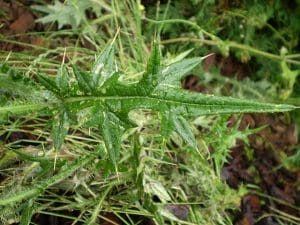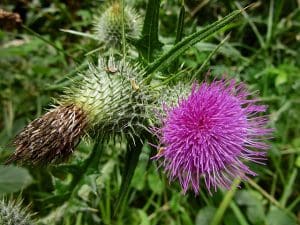Spear Thistle / Spring / Summer / Autumn / Edible
Spear Thistle is a native, biannual member of the daisy family. It’s massively common and the stems can be used as a celery substitute.
Common Names
Spear Thistle, Bull Thistle, Scotch Thistle
Botanical Name
Cirsium vulgare
Scientific Classification
Kingdom – Plantae
Order – Asterales
Family – Asteraceae
Physical Characteristics for Spear Thistle
Leaves
The plant develops two types of leaves, the basal leaves grow from a rosette. These are spear shaped, deeply lobed and are covered in sharp spines. Up to 30cm long. From the centre of the rosette a flowering stalk emerges, which can be up to 1.5 metres tall. The leaves from this are spear shaped and much smaller.

Flowers
The flowers form a purple to mauve inflorescence that can be up to 5cm in diameter. One of the key ID features of Thistles are the overlapping bracts (involucre) found directly below the flowers.

Seeds
The tiny seeds are wind dispersed, they are all attached to clumps of fine hairs called pappus. They look a little like a dandelion clock.
Habitat
It’s one of the most common weeds in the UK and can be found almost anywhere. Most often it’s found on waste ground and the edges of farmers’ fields.
Known Hazards
None known.
Could be Confused with…
It’s a plant most of us are familiar with and it would be hard to confuse it with anything else other than different Thistles species but they can all be used in a similar way.
Edible Uses
Believe it or not they are a tasty treat, the leaves and stems can be eaten raw as a crudité or cooked. But the spines have to be removed first. Simply cut them off with a sharp knife and peel off the outer skin.
As a relative to Globe Artichokes they do produce edible ‘chokes’. The unopened flower buds can be boiled and eaten in a similar way, peeling away the bracts to get to the soft flesh inside.
If you have the landowners permission you can also eat the roots, when roasted it has a similar flavour to Burdock.
Notes on Herbal Uses
The plant is known to be high in fibre, protein, phosphorus, magnesium, calcium, copper, and zinc.
In herbal medicine it is used to treat swelling of joints and tendons, rheumatoid arthritis, and inflammatory bowel syndrome.
Extra notes from the Foragers
If you are going to harvest Thistles go well prepared! Wear gloves and try to protect your eyes.
They are quite difficult to process but they are worth the effort.
The flowers are the national emblem of Scotland, legend goes that when Vikings used to pillage the Scottish shores, a raiding army were about to ambush a small village. When approaching the victims, one of the Vikings stepped on thistles and the pain was so intense that the screams awakened the whole valley, saving it.
References:
https://www.permaculture.co.uk/articles/thistles-high-nutrient-weed
https://en.wikipedia.org/wiki/Cirsium_vulgare
https://www.permaculture.co.uk/articles/thistles-high-nutrient-weed










Leave a Reply
You must be logged in to post a comment.